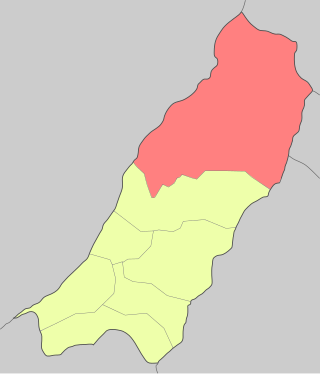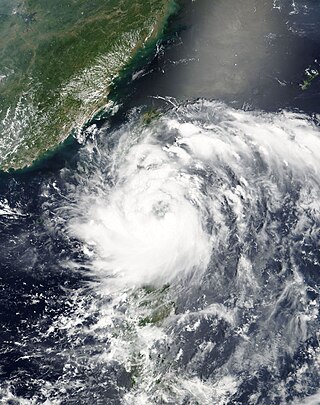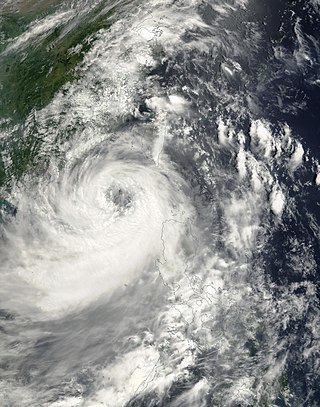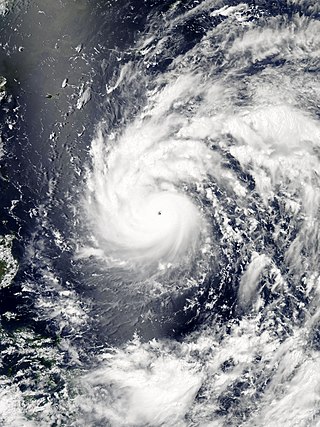
Typhoon Herb, known in the Philippines as Typhoon Huaning, was the strongest and the largest storm of 1996. Herb struck the Ryūkyū Islands, Taiwan and the People's Republic of China, causing major damage. The name Herb was used in the Western Pacific name list for the first time after the list had been revised earlier in 1996. Although the name was not retired, the Western Pacific name list was changed from English names to Asian names in 2000, so 1996 was in fact the only occasion when the name was used

Typhoon Aere, known in the Philippines as Typhoon Marce, was a mid-season category two typhoon that brought severe damage to Taiwan and the People's Republic of China in August 2004. Aere is the Marshallese word for 'storm'.

China is a mountainous country, which leads to rapid dissipation of cyclones that move inland as well as significant amounts of rain from those dissipating cyclones. Typhoon Nina in 1975 caused the collapse of two huge reservoirs and ten smaller dams when 1062 mm (41.81 inches) of rain fell in Henan Province during a 24‑hour period. Super Typhoon Carla was the wettest tropical cyclone on record for mainland China. Since 1957, there has been a downward trend in tropical cyclone rainfall for the country.

Typhoon Sinlaku, known in the Philippines as Typhoon Marce, was a typhoon which affected the Philippines, Taiwan, China and Japan. It was recognised as the 13th named storm and the ninth typhoon of the 2008 Pacific typhoon season by the Japan Meteorological Agency.

Typhoon Wipha, known in the Philippines as Super Typhoon Goring, was the strongest typhoon to threaten the Chinese coastline since Typhoon Saomai in August 2006. Forming out of a tropical disturbance on September 15, 2007, it quickly developed into a tropical storm, and intensified into a typhoon the following day with the appearance of an eye feature. After a period of rapid intensification, Wipha attained its peak intensity on September 18, with winds of 185 km/h (115 mph) and a barometric pressure of 925 mbar (hPa), according to the Japan Meteorological Agency. Later that day, the storm began to weaken as it interacted with the mountainous terrain of Taiwan before brushing the northern edge of the island. Wipha subsequently made landfall near Fuding along the Fujian–Zhejiang provincial border with winds estimated at 185 km/h (115 mph) by the JTWC. Shortly thereafter, the typhoon weakened as it moved inland, weakening to a tropical storm within 18 hours of moving over land.

Siaolin Village, also spelled Xiaolin Village, is a village in Jiasian District, Kaohsiung, Taiwan. It is mostly agricultural and home to one of the largest communities of the Taivoan people.

Typhoon Fanapi, known in the Philippines as Typhoon Inday, was a damaging and deadly typhoon that struck Taiwan and southeastern China in September 2010. It was the eleventh tropical storm and fourth typhoon of the very inactive season. The storm formed on September 14 east of the Philippines and moved slowly for several days, initially to the northwest, then curving to the northeast before turning westward due to a ridge to the north. During this time, Fanapi intensified to reach 10 minute maximum sustained winds of 175 km/h (109 mph). Fanapi made its first landfall on September 19 over Hualien, Taiwan, becoming the first typhoon to hit the island since Typhoon Morakot in August 2009. Later that day made a final landfall in Fujian, China. The storm dissipated on September 21 over southern China.

Typhoon Nanmadol, known in the Philippines as Super Typhoon Mina, was the strongest tropical cyclone in 2011 to hit the Philippines and also the second most intense tropical cyclone worldwide in 2011, and the first of the year to directly impact Taiwan and the rest of the Republic of China (ROC). Becoming the eleventh named storm, the seventh severe tropical storm and the fourth typhoon of the 2011 Pacific typhoon season, Nanmadol made a total of three landfalls killing 26, and causing widespread damage worth US$26,464,591. The area of low pressure that was about to become Nanmadol formed on August 19. It drifted north and became a tropical depression on August 21, a tropical storm on August 23 and a typhoon on the same night. Nanmadol reached peak strength with winds of 105 knots and 140 knots threatening the Philippines with heavy rain and flash flooding.

Tropical Storm Aere, known in the Philippines as Tropical Storm Bebeng, was a mild tropical storm that affected eastern Philippines and southern Japan. It was the first named storm of the 2011 Pacific typhoon season. Aere is the Marshallese word for storm.

Typhoon Lynn, more commonly known in the Philippines as Typhoon Pepang, was responsible for the worst flooding in Taiwan in 40 years. Typhoon Lynn originated from an area of disturbed weather in the central north Pacific in mid-October 1987. On October 15, the system was upgraded into a tropical storm. Moving west-northwest, it slowly deepened over the next few days, though the intensification process briefly stopped on October 15. Two days later, Lynn was upgraded into a typhoon, while passing northwest of Guam. Lynn maintained low-end typhoon strength until October 19, when the storm began to rapidly intensify. On October 21, Lynn attained its peak intensity while tracking towards the west. Weakening then commenced soon after Lynn interacted with Luzon. However, the core of the typhoon remained well offshore both the Philippines and Taiwan. On October 25, Lynn weakened to a severe tropical storm. Three days later, it dissipated, though its remains later brought rain to China.

Typhoon Saola, known in the Philippines as Typhoon Gener, was a strong tropical cyclone affecting the Philippines, Taiwan and China. It was the ninth named storm and the fourth typhoon of the 2012 Pacific typhoon season. Saola is the name of a rare mammal found in Vietnam.

Typhoon Dujuan, known in the Philippines as Typhoon Onyok, was the strongest tropical cyclone to strike the Pearl River delta since Typhoon Hope in 1979. The 13th storm and 7th typhoon of the 2003 Pacific typhoon season, Dujuan developed on August 27 to the east of Taiwan. It initially moved to the northwest, slowly intensifying into a tropical storm while drawing moisture and rainfall over the Philippines. On the island of Luzon, one person was killed and areas were flooded. Dujuan quickly intensified after turning and moving quicker to the west-northwest, developing an eye. It reached peak winds of 150 km/h (93 mph) on September 1, and shortly thereafter passed just south of Taiwan. There, Dujuan left 590,000 people without power, killed three, and caused NT$200 million in crop damage. While moving through the South China Sea, the typhoon developed concentric eyewalls. Dujuan weakened to severe tropical storm status before making landfall on September 2 in southern China, just east of Hong Kong near Shenzhen, Guangdong. The storm dissipated the next day after causing 40 deaths and ¥2.3 billion in damage. Most of the deaths were in Shenzhen where the storm moved ashore, and the city experienced a near-total power outage.

Tropical Storm Morakot, known in the Philippines as Tropical Storm Juaning, brought significant rainfall to Taiwan before alleviating drought conditions in mainland China in August 2003. The tenth named storm in the western Pacific that year, Morakot spawned from an area of disturbed weather in the Philippine Sea on July 31. Tracking northwest, favorable conditions allowed for the intensification of the system to tropical storm strength on August 2. Morakot reached peak intensity later that day with winds of 85 km/h (50 mph) and a minimum barometric pressure of 992 mbar. This intensity was held for several hours until less conducive atmospheric conditions slightly weakened the system; this was followed by Morakot making landfall on southern Taiwan on August 3. Subsequently, the storm weakened and moved into the Taiwan Strait before making its final landfall near Quanzhou, China the next day. The storm quickly weakened over the Chinese mainland, and dissipated entirely several hours after landfall.

Severe Tropical Storm Utor, known in the Philippines as Typhoon Feria, was a large and deadly system that caused heavy rains and landslides throughout the Philippines, Taiwan, and China. The eighth tropical depression and fourth named storm of the 2001 Pacific typhoon season, Utor formed on July 1 and intensified into a tropical storm shortly after. Utor was upgraded to a typhoon by the JTWC on July 3, and a day later, Utor was estimated to have peaked with 10-min winds of 110 km/h (70 mph), with the JTWC estimating 1-min winds of 150 km/h (95 mph). After passing just north of Luzon, Utor began to weaken, before making landfall on the district of Dapeng as a minimal typhoon. Utor caused 203 deaths, of which 168 were in the Philippines, 23 were in the province of Guangdong, 10 were in the province of Guangxi, and 2 were in Taiwan. Total damages from the storm amounted to $2.78 billion.

Typhoon Dujuan, known in the Philippines as Super Typhoon Jenny, was the second most intense tropical cyclone of the Northwest Pacific Ocean in 2015 in terms of ten-minute maximum sustained winds, tied with Noul. The twenty-first named storm and the thirteenth typhoon of the 2015 Pacific typhoon season, Dujuan brought extremely powerful winds throughout the Yaeyama Islands and Taiwan in late September, causing 3 deaths in Taiwan. The typhoon also caused over ¥2.5 billion (US$392.9 million) damage in East China.

Typhoon Nepartak, known in the Philippines as Super Typhoon Butchoy, was the third most intense tropical cyclone worldwide in 2016. Nepartak severely impacted Taiwan and East China, with 86 confirmed fatalities. It caused 3 deaths and NT$678 million of damage in Taiwan. Moreover, Nepartak also had disastrous effects in Fujian, China, causing 111 deaths and ¥9.99 billion of damage. After the season, total damages exceeded up to ¥12.65 billion.

Typhoon Megi, known in the Philippines as Typhoon Helen, was a large and powerful tropical cyclone which affected Taiwan and eastern China in late September 2016. It is the seventeenth named storm and the seventh typhoon of the annual typhoon season. Megi started as a tropical disturbance in the northeast of Pohnpei. On September 21, JMA upgraded the disturbance to a tropical depression. The depression was immediately named Megi by the JMA as it was classified as a tropical storm. It was later then designated by JTWC as a newly formed Tropical Depression 20W. Moving northwestwards, Megi was trying to form an eye which prompted the agencies to upgrade into a typhoon. Megi later entered PAR, attaining the name Helen as it continued to intensify. Favorable conditions and low vertical wind shear allow Megi to perform an eyewall replacement cycle as it approaches Taiwan.

Typhoon Nesat, known in the Philippines as Typhoon Gorio, was a strong tropical cyclone that impacted Taiwan and Fujian, China. It was the ninth named storm and the second typhoon of the annual typhoon season. After consolidating slowly for several days, Tropical Storm Nesat developed east of the Philippines on July 25. While experiencing favorable environmental conditions such as very warm sea surface temperatures and low wind shear, Nesat strengthened into a typhoon and reached its peak intensity on July 28. On July 29, the typhoon made landfall near the Taiwanese city of Yilan, before weakening to a severe tropical storm and making landfall again near Fuqing on China's east coast late the same day. Moving into July 30, Nesat continued to weaken under the effects of land interaction.

Tropical Storm Lupit, known in the Philippines as Tropical Storm Huaning, was a tropical cyclone that affected Hong Kong and Macau, while also impacting the Guangdong and Fujian provinces in Mainland China, Taiwan and Japan in early-August 2021. The ninth named storm of the 2021 Pacific typhoon season, the system was first tracked as a tropical depression by the Japan Meteorological Agency (JMA) as a tropical depression over Zhanjiang. It then moved east-northeastward, affecting Hong Kong and Macau before strengthening to a tropical storm, whereas it was named Lupit. On August 5, as it neared the coast of Guangdong Province, it slightly intensified before the storm made two consecutive landfalls over Nan'ao County in Guangdong and Dongshan County in Fujian on that day. It then turned towards Taiwan before striking the northern part of the country. After lashing the area with torrential rainfall that led to numerous landslides and unknown damages, it approached and made two consecutive landfalls at mainland Japan before entering the Sea of Japan, in where it became extratropical.


























